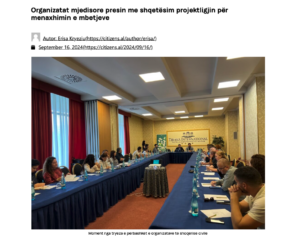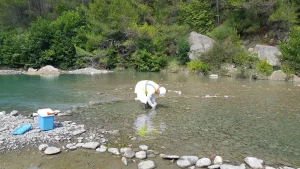On July 1st, a large-scale fire broke out at the landfill of Elbasan, releasing hazardous pollutants into the atmosphere and severely impacting the surrounding environment and public health. In response, a joint team of environmental experts from Co-PLAN and Milieukontakt conducted on-site monitoring to assess the consequences of the fire on air quality.
In Albania, landfills, whether sanitary or not, remain the dominant form of final waste disposal. However, recent years have witnessed a worrying increase in the frequency of fires at these sites, which release harmful emissions and pose direct threats to the environment and public health.
Landfill of Elbasan field measurements
The measurement taken in the landfill during the fire event revealed critical levels of airborne pollutants, indicating direct health and environmental risks:
Carbon Dioxide (CO₂): 521–794 ppm
These levels far exceed the standard baseline of ~350 ppm, indicating uncontrolled combustion of organic materials, dangerous for both human health and the surrounding ecosystem.
Methane (CH₄): 5–8 ppm
Ambient methane levels are typically ~1.8 ppm. These elevated values signal ongoing anaerobic decomposition of waste, posing a potential explosion risk under fire conditions.
Nitrogen Dioxide (NO₂): up to 331 µg/m³
This measurement significantly surpasses the EU’s short-term exposure limit of 200 µg/m³ (1-hour), indicating a serious respiratory hazard for nearby residents.
Volatile Organic Compounds (VOCs): up to 6,800 µg/m³
VOC concentrations exceed EU-recommended thresholds and are extremely dangerous, with toxic and carcinogenic potential. They also contribute to ground-level ozone formation, further worsening air quality.
PM2.5 and PM10
While still within 24-hour permissible limits, the proximity to the landfill fire means even these levels can be harmful, particularly for sensitive groups and individuals with pre-existing respiratory conditions.
Speaking to Report Tv, GreenAL project manager, Imeldi Sokoli, stated that: “In the city of Elbasan, we have two monitoring stations. During the fire, the parameters shifted from moderate pollution to unhealthy levels for individuals sensitive to respiratory issues. It is advisable to minimize exposure in the area,” said Sokoli.
He further added: “Something else should also be mentioned here: that the landfill, in general, in the hierarchy of the waste management pyramid, is the last stage, where we send waste to be disposed of. It is not advisable for it to be located near water bodies, because the waste from this deposit can infiltrate into aquifers and underground layers,” the expert said.
The situation in Elbasan is part of a broader pattern. The Vlora landfill has also experienced repeated fires over the years, becoming a chronic environmental and health concern. These recurring incidents point to an urgent need for structural improvements and effective interventions in waste management and fire prevention.
This monitoring initiative was carried out in the framework of the #GreenAL project, funded by the Swedish International Development Cooperation Agency (Sida) through the Embassy of Sweden in Tirana, and implemented by Co-PLAN, Institute for Habitat Development, in partnership with VIS Albania, COSV Albania, and Milieukontakt Albania, member of the Milieukontakt International Network.




